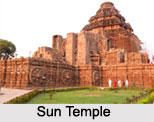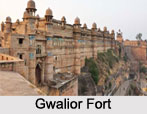 Architecture of the West India consists of the Indo-Aryan temples of Gujarat, cave shrines of Maharashtra and the temples of Kathiawad and Kutch which were constructed during the 10th century. The renowned Jain sanctuaries of Mount Abu in Rajputana in Rajasthan are also noteworthy for its exquisite architecture.
Architecture of the West India consists of the Indo-Aryan temples of Gujarat, cave shrines of Maharashtra and the temples of Kathiawad and Kutch which were constructed during the 10th century. The renowned Jain sanctuaries of Mount Abu in Rajputana in Rajasthan are also noteworthy for its exquisite architecture.
Architecture in the western India is predominant in the Indo-Aryan buildings in the city of Gwalior where there is a blend of Hindu and Buddhist architectures. Western part of India is recognized as the land of historical edifices and relics. Mumbai"s Gothic architecture is embodied in the Gateway of India, Mumbai High Court, Old Secretariat, University Buildings and Victoria Terminus. Significance checking out is the ancient city of Aurangabad, whose nearby attractions comprise two magnificent rock-cut caves of Ajanta and Ellora.
History of Western Indian Architecture
A brief peep into the history of architecture of West India would take one to the ancient era of cave temples and rock cut monuments. The architectures of Ajanta and Ellora caves in Maharashtra bear testimony to this fact. However, with the emergence of Shivaji in the political scenario several forts were built here. With the passing time West India witnessed changes in the style of its architecture. Under the Rajputs, a new school of art and architecture evolved. This style was partly influenced by the Mughals. At this point of time Rajasthan became a primary seat of architecture.
 Numerous forts, palaces, gardens, havelis, temples, both Hindu and Jain, were extensively built. The Rajput"s love for grandeur is obvious even today from these monuments. Whilst Rajasthani architecture basked in the glory of royal grandeur, religious monuments built throughout Gujarat. The colonial introduced completely different schools of art and architecture to India. This style is evident from the buildings of Goa.
Numerous forts, palaces, gardens, havelis, temples, both Hindu and Jain, were extensively built. The Rajput"s love for grandeur is obvious even today from these monuments. Whilst Rajasthani architecture basked in the glory of royal grandeur, religious monuments built throughout Gujarat. The colonial introduced completely different schools of art and architecture to India. This style is evident from the buildings of Goa.
Features of Western Indian Architecture
As far as the architecture of West India is concerned, the caves shrines and chaityas of Maharashtra demonstrate the aspects of Buddhist architecture which was so prevalent in ancient India. There are more numerous temples in the western parts of India, including Gujarat, Rajasthan and Madhya Pradesh.
The most famous of the Gujarat temples was the Lord Shiva shrine at Somanatha-Patan which was the special object of Mahmud of Ghazni `s fury and religious zeal against idolatry. Similar architecture is perceived in the ruined temples of Navalakha at Sejakpur and Ghumli. The polygonal hall with its multiple step-backs in plan precedes a cella set in the core of an attached sikhara. The sikharas differ from the usual Indo-Aryan type in being composed of clustered turrets, each a replica of the main tower, and almost free-standing from the fabric of the principal spire.
The Sun Temple: Situated in Modhera in Gujarat, it is another distinct example of architecture in western India which was built by Raja Bhimdev I of the Solanki Dynasty. There is a massive rectangular stepped tank called Surya Kund in front of it. Huge ornamental arch-torana leads one to the sabha mandapa which is open on all sides as it was the fashion of the times in western and central India temples. The Surya temple consists of an open pillared porch connected by a narrow passage to a building containing an assembly hall and the garbhagriha itself. The sculpture at Modhera is not far removed from the famous carved domes at Mount Abu.
Telika-Mandir: The earliest of these is the Telika-Mandir of the 11th century. This design is unique in later Hindu architecture and the roof is in the shape of a barrel-vaulted chaitya with the sun-windows of the Buddhist type plainly indicated at each end; the resemblance to the Buddhist basilica type extends to the representation of arcades. This is one of the last appearances of the rare Vesara type of temple.
The architecture of Goa: This stands out amidst the others in West India. The buildings here display an Indo-Portuguese style of architecture. There are several heritage buildings, though most of these are in ruins. Catholic churches and temples are part of its religious architecture.
Jain Architecture of Rajasthan: The renowned Jain sanctuaries of Mount Abu in Rajputana in Rajasthan mark the final baroque culmination of the Gujarat style of architecture. The most famous buildings are the Dilwara temple of the 10th century and the Tejpal temple of the 13th century. A little group of disused and largely ruined temples and fragments of shrines crown the plateau of Gwalior Fort.
Thus, the architecture in West India is, primarily, an amalgamation Hindu, Jain and Buddhist architectural styles. Although most of the architectural monuments are in ruins but most of them bear testimony of the magnificent past.



















